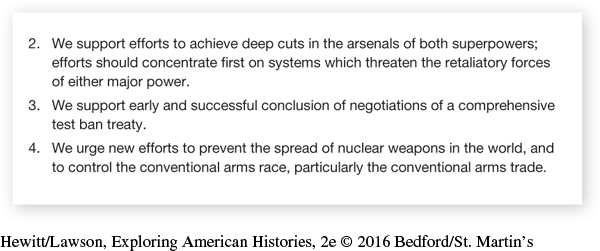Introduction to Chapter 28
28
The End of the Cold War and the Challenge of Globalization
1969–1991
WINDOW TO THE PAST
United States Conference of Catholic Bishops, Pastoral Letter on War and Peace, 1983
Many Americans worried over President Reagan’s buildup of the U.S. nuclear arsenal against the Soviet Union and called on both sides to initiate a nuclear weapons freeze. In 1983 U.S. Catholic bishops wrote this pastoral letter with recommendations to lessen the threat of nuclear war. To discover more about what this primary source can show us, see Document 28.3.

LEARNING OBJECTIVES
After reading this chapter you should be able to:
Explain how President Nixon reduced Cold War tensions.
Evaluate President Carter’s foreign policy concerning human rights, the Soviet Union, and the Middle East.
Discuss Ronald Reagan’s role in ending the Cold War and fighting international terrorism.
Analyze the events leading to the conclusion of the Cold War, and assess the effects of its cessation on the relationships between the United States and the rest of the world.
AMERICAN HISTORIES

As secretary of state, George Pratt Shultz presided over the end of the Cold War. A skilled mediator, Shultz believed in hard-nosed diplomacy, asserting that “negotiations are a euphemism for capitulation if the shadow of power is not cast across the bargaining table.” After graduating from Princeton with an economics degree in 1942, the twenty-two-year-old Shultz joined the Marine Corps and served in the Pacific during World War II. After the war, he earned a Ph.D. in industrial economics and taught at the Massachusetts Institute of Technology and the University of Chicago. In 1955 he joined President Eisenhower’s Council of Economic Advisors, the first of many government posts he would fill in the Kennedy, Johnson, and Nixon administrations before he left government for the corporate world.
In 1982 Shultz returned to Washington to serve as President Ronald Reagan’s secretary of state. Like Reagan, Shultz believed that the United States needed to reassert itself as a global power and rebound from the insecurity and self-doubt that followed the Vietnam War. The president believed that a tough approach would bring peace, and he revived the fiery rhetoric and military preparedness of the darkest days of the Cold War. As an economist, Shultz doubted that the Soviet Union was financially able to sustain its military strength, and his predictions proved correct. Faced with an escalating arms race, a fresh group of Soviet leaders decided to pursue peaceful relations.

While President Reagan and Secretary of State Shultz advocated confrontation with the Soviet Union, Barbara Deming challenged their efforts and devoted her life to promoting peace in a far different manner. Born in 1917 to a middle-class family living in New York City, Deming graduated from Bennington College and became an outspoken proponent of nuclear disarmament, feminism, civil rights, and pacifism. Her radical political beliefs and her recognition that she was a lesbian at the age of sixteen placed her outside the social and cultural mainstream. She lived in a women’s commune and mobilized women to demonstrate for peaceful coexistence with the Soviet Union.
In the 1980s, Deming applied her pacifist beliefs against Reagan and Shultz’s muscular approach to fighting the Cold War. As part of a worldwide campaign against the deployment of nuclear weapons, she joined the Women’s Encampment for a Future of Peace and Justice, which opened in western New York in 1983 next to an army depot that stored nuclear missiles. On July 30, 1983, Deming led a march of seventy-five female activists into the small town of Waterloo. “Four miles into our walk,” she recalled, “our way was blocked by several hundred townspeople brandishing American flags and chanting, ‘Commies, go home!’” The marchers then sat down in nonviolent protest, and the police arrested Deming and fifty-three other protesters. Demonstrations continued throughout the rest of the summer, inspiring protests in other American communities and throughout Europe.
The American histories of George Shultz and Barbara Deming were shaped by decades of conflict between the United States and the Soviet Union. Both Shultz and Deming believed that the conflict was one of the defining issues of their times, and both were convinced that their approach was the best way to achieve lasting global peace.
Although President Nixon helped reduce Cold War tensions with the Soviet Union, his successors alternated between cooperation and confrontation until the conflict came to an end. In the late 1970s President Jimmy Carter emphasized the moralistic diplomacy of human rights, but by the end of his term he had increased the size of the U.S. military in response to Soviet aggression in Afghanistan. His successor, Ronald Reagan, employed harsher rhetoric and accelerated the military buildup begun under Carter. The Cold War came to an end aided by Soviet leader Mikhail Gorbachev. Peace activists also contributed to reducing the prospects of nuclear war. With the collapse of the Soviet Union and its empire, the United States became the world’s sole superpower. At the same time, the United States had to operate in an increasingly globalized world and face tests of its strength in Central America, the Middle East, and the Persian Gulf.
Exploring American HistoriesPrinted Page 929
Exploring American Histories Value EditionPrinted Page 687
Chapter Timeline